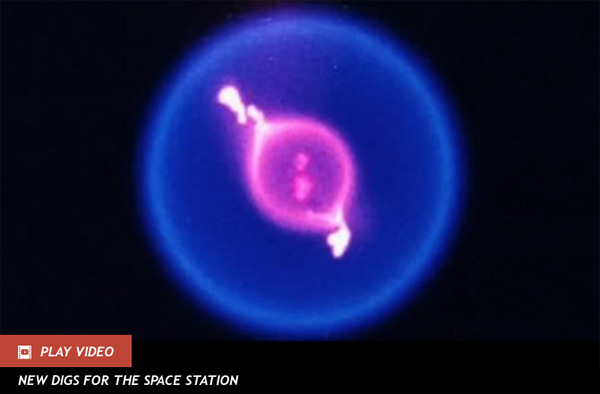Cool Flames: Playing With Balls of Space Fire
Cool Flames: Playing With Balls of Space Fire
Making fire was a fundamental evolutionary step for our civilization, so you’d think that we’d totally understand the phenomenon inside and out by now. But, as experiments on the International Space Station (ISS) are proving, fire is a very different and mysterious creature when it burns in a microgravity environment.
Usually, flames in the presence of gravity (i.e. on Earth) form under complex chemical reactions. But gravity ensures that the flame on a candle, say, forms a ‘droplet’ shape — hot air rises, pulling in cool air behind it, shaping the flame. But in the absence a strong gravitational field — like the microgravity environment in the ISS — fire transforms into a very alien configuration.
“In microgravity, flames burn differently — they form little spheres,” said Forman A. Williams, a professor of physics at UC San Diego, in a fascinating NASA Science article published today (June 18).
During experiments on the orbiting outpost, these small burning spheres were created inside the Flame Extinguishment-2 (FLEX-2) instrument using the highly flammable liquid hydrocarbon heptane. When ignited, a hot flame surrounded the droplet, burning at a temperature of between 1,500K and 2,000K.
On Earth, a flame will burn in the presence of oxygen, growing rapidly to “suck up” as much oxygen as possible. But the microgravity environment inside FLEX-2 promotes an entirely different kind of flame behavior. After ignition, the oxygen and heptane fuel combine in a narrow zone at the surface of the sphere where it burns. Rather than hungrily expanding to pull in oxygen like its terrestrial counterpart, the microgravity flame stays put, burning as oxygen flows towards it (pictured top).
As explained by NASA: “Flaming spheres on the ISS turn out to be wonderful mini-labs for combustion research.”
But a surprise was in store for the FLEX-2 scientists.
During a recent experiment inside FLEX-2, the flame of the burning heptane was extinguished, but to the team’s surprise, the droplet of fuel continued to burn. It was burning without a visible flame.
“That’s right—they seemed to be burning without flames,” says Williams. “At first we didn’t believe it ourselves.”
Actually, as it turns out, there was a flame, but it was a very cool flame — a totally unexpected regime of burning never before realized in space. “Cool flames burn at the relatively low temperature of 500K to 800K,” says Williams. “And their chemistry is completely different. Normal flames produce soot, CO2 and water. Cool flames produce carbon monoxide and formaldehyde.”
Attempts to create cool flames on Earth have failed; they flicker and go out before they have a chance to take hold. Cool flames have also been researched by the automobile industry in the hope of developing a cleaner auto ignition, for example. These ISS experiments could help the industry with their quest for non-polluting ignition technologies.
Fire still holds a primeval fascination over the human psyche, but watching the balls of fire burn in space adds a very alien twist to what should be a familiar phenomenon.(Jun 18, 2013 04:13 PM ET // by Ian O'Neill)












